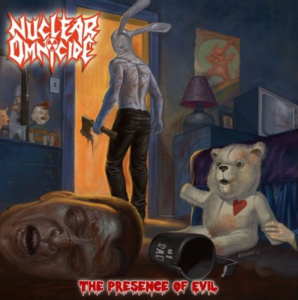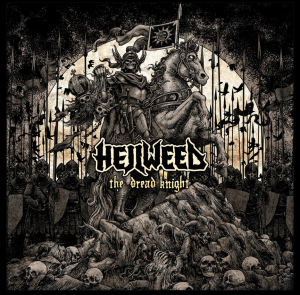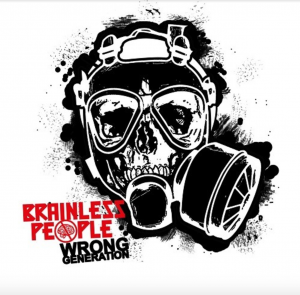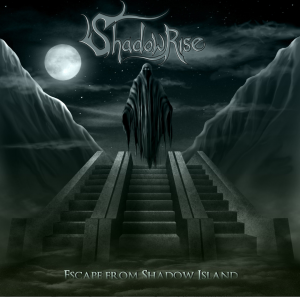Heavy Metal Detector – a conversation with Steve Maher
Mon 14 Aug 2017Hi Steve,
Thanks for sending over images of the music you have featured in past iterations of Heavy Metal Detector. This probably sounds naive, but I was surprised at how different each cover looks. Did you have any unexpected moments in the project that’s made you reassess the music genre as you had previously imagined it?
Yes, very much so. I should probably make clear that I didn’t begin this project as a metal expert. My interest in metal as a musical genre is rooted (mostly) in my interest in aesthetics and cultural practice. I do appreciate the music of course, but I am more into John Hughes soundtracks and Kitaro. That being said, I played in hardcore bands as a teen, which isn’t very far off. I think the unexpected thing for me, initially, was the complexity of creative practices and styles in the scene and throughout its sub-groups. Metal is diverse in its sound and practitioner base but the external perception is very stereotyped particularly regarding its range of experiences and values. On the whole, metal musicians are experienced creatives and open to new experiences. The scene itself, and one’s involvement in it, requires a rather significant shift from what’s considered ‘mainstream’, in terms of aesthetic appreciation and you can see this when you interact with the bands.
Dai Kaht’s sound is just as interesting as their cover art. They are young guys but you get the impression that their music is rooted in an understanding of the history of their genre. They have strong prog rock influences in their groove and guitar work but also in the vocal style which is sometimes like early DC melodic hardcore or it can be anthemic. There is also an optimism to their sound in the surf rock guitar progressions and rhythm. To top it off all of their song titles are great, which is a facet of rock music which shouldn’t be underestimated.
I think Dai Kaht, are a good example of the range of musical and visual inspiration you’ll find in the genre which is represented in the cover art. You can easily see what inspires and influences them and this is reflected in how they choose illustrate their music. In Hellweed, we can see a lot of signifiers from Norse cover art, however they are a metalcore group from Moscow.

Nuclear Omnicide, The Presence of Evil, 2013, Helsinki, Finland
In collaboration with Hellweed, I created an iteration of Heavy Metal Detector as part of the Moscow Biennale for Young Art in 2016. This took the form of an interactive installation. We placed a metal detector inside an oversized papier mache cosplay medieval sword. To me, this is more of a Slavic medieval style than norse inspired, which has come to be very popular in that part of the world. Hellweed borrow from this specifically to criticise the Russian Orthodox Church which adopted a pseudo Medieval-Gregorian persona when they reformed after the fall of the Soviet Union. The band use an imperialist style to criticise the contemporary adaptation of such imagery. In Russia you can really only be openly outspoken about history, so people make use of this through an ironic comparison equating the regimes from Russia’s history to the regime’s of today. You can hear this in their music which is a blend of contemporary street level metal-hardcore and politically aware lyrics full of metaphors. As an aside they also love Rugby, this was our initial common ground when collaborating.
Nuclear Omnicide, like all good thrash metal, makes heavy use of ironic imagery but in the genre there is a “no-nonsense” grunge influenced aesthetic. There is an impression of this sort of Hesher persona, but the use of “slasher” imagery is like David Lynch’s obsession with serial killers and Americana, it’s more than just a shock factor. The image makes use of a trope –it’s not a Finnish bedroom, Finnish light switch or a teddy bear – it is reminiscent of the graphic novel style of album art we saw in the Nu-metal scene of the early 2000’s. Inspired by comics like Todd McFarlane’s Spawn and then appropriated by groups like Korn and Slipknot. Nuclear Omnicide don’t have that backstory, at least not exclusively, they are a blend of a lot of popular forms against the backdrop of a uniquely urban ‘Helsinkilainen’ attitude – where global culture encroaches and young people try to make what is on offer their own.

Dai Kaht, Dai Kaht, 2017, Kajaani, Finland
What can you tell me about the inspiration for Heavy Metal Detector, what got you started and why did you choose Heavy Metal music?
I moved to the Nordics, specifically Helsinki, Finland, in 2013. I had a few ideas about the region but they were fairly two dimensional. I knew there was snow, reindeers somewhere, and metal. I had also heard about church burnings and other spectacles. When I moved to Helsinki I realised how ubiquitous metal was – bus drivers listened to it – and there are a slew of bars and venues which cater to the scene. Basically, even at street level, you can see how the place advocates metal, it is very present there.
Per capita Finland has more metal bands than anywhere else in the world, but at the same time it is still not necessarily everyone’s cup of tea. I read an article about a neurological study of two communities of music listeners and it turns out that the brain structure of classical music aficionados and metal music fans are very similar. When you reflect on the theatrical nature of each genre that makes sense to me. This led me to wonder what a new platform for the dissemination of music could look like. I especially wanted to focus on ways that you could make this a participatory process, and how that process could be physical.
Obviously, the name came first. How could it not? I began to explore the process of metal detecting, specifically how it could relate to music and music appreciation. I found that the practice of metal detecting positions the detector in an attentive position, it requires the user to think about dimensions of the space around them and the materials within it in a manner that combines a lot of different sensory perception. When you scan the floor and you find metal material the device represents it as a beep. I replaced that sound with local underground music to make the experience of listening more engaging. There is of course all these obvious metaphors at play, but for me they service the work as a way to make the project more digestible in its many layers of participation.

Hellweed, The Dread Knight, 2014, Moscow, Russia
I’m intrigued, what’s relationship do you have with the bands that you promote through the work?
I don’t make choices in this project based of my own tastes, I manoeuvre through contacts established in the local scene. I contact bands based on recommendation or word of mouth and in one case a band sought me out to be involved. I do this in order to be representative of the local scene, young and old, amateur and professional. First, I approach a band and ask them if they are interested in participating. Next, we have a dialogue about the Heavy Metal Detector project. I ask them what they think and if they would be interested in being a part of it. I then ask bands to select their track primarily based on their interpretation of the project and we usually have a discussion about their selection and if it is representative of their catalogue. Sometimes bands will ask if it’s OK to promote a new release. I impose very little restriction and let the bands dictate the level of involvement they want to offer. Some participate but are standoffish, others are really involved, and participate in the tours and network with the other groups taking part. We often have to deal with the record label. Most times they are a small label who are easy to contact, but sometimes it’s a label like Sony who are surprisingly accommodating!

Brainless people, Wrong Generation, 2016, Helsinki, Finland
Over the last couple of decades the music industry as we knew it has been dismantled and rebuilt to reflect the age of the internet. How does distribution and dissemination play a role in the project?
The advent of Spotify and other streaming services means that there is a disassociation between popular culture and the means of access to new music. All at once we are offered a multitude of lifetimes of music, the avenues and algorithms which dictate what we encounter become more and more refined and as a result grow dangerously homogenous. We are left in a position where the cultural practice of how music was discovered has been nearly erased. The traditional mediums of musical appreciation (print and television), while confined and clumsy, offered a beauty in their chains. This is now replaced by a screen less than 50 centimetres from your face. The capacity for us to see other things outside of this perspective is eroding, everything is a pop-up. Then again, in the corners of the web, new communities are emerging that on the whole we don’t even realise exist. People are revisiting the past and curating their own experiences, where you see this is all going depends on how optimistic you are about human nature.
I grew up as part of a community that existed on word of mouth and have older brothers who had magazine subscriptions to music magazines, which I read. The format inevitably has changed and young people will not intentionally limit themselves and find new ways to find what they want, but we are left with less platforms of dissemination, as in one, which is worrying. So I am interested in pushing the boundary of musical appreciation in response to this. I also like levelling out the different disciplines, positioning music or hybridising it in social practice is one answer for me in response to this erosion, I hope that it offers the same possibilities for others.
How do you see Heavy Metal Detector working in Castleton? What can visitors expect to experience when they take one of your tours?
Castleton is idyllic. I think it will be stark contrast to the piece, but a refreshing one. The name is on the tin with this, but I think the expectation versus the impact always catches people off guard, particularly as the project forces participants to focus on the activity at hand for an average of 30-45 minutes. We don’t really listen to music in the same way as we used to. For instance, the focus has shifted away from listening to a whole album to bite-sized three minute mp3s. Externally I think the locals will get drawn into what is going on, it looks fun!

What are you working on at the moment?
Besides from preparing for the AND Festival, I will be touring Heavy Metal Detector in Europe for the rest of 2017 and am collaborating with the famous Melkweg venue in Amsterdam as part of a Heavy Metal Film Festival in November. In addition to that I am building a “Po-Mo Ghost Hunting Kit” which I aim to use across a variety of cultural institutions next year. The work is about coming to terms with the spectres of Modernist and Postmodernist ideology. As part of our artist run gallery in Helsinki, Third Space, I am working in collaboration with Raine Vasqeuz and Sébastien Piquemal on a project which adapts wifi technology for a city wide art exhibition. We will be traveling with this work to Brooklyn, New York, to present our project at Radical Networks. I am helping to produce Pixelache 2017 in Helsinki, which launches on the same weekend as AND so unfortunately I won’t see the fruits of my work. I am also working on a project funded by Taike in Finland which looks at the use of J.R.R. Tolkien’s Elvish language ‘Quenya’ as a potential way to negate the neo-colonial economic encroachment of the English language. In what free time I have left I am buying cheap tat on ebay!
Thanks! Cheers!
Recent Journals
- AND’s new Board Members and Associate Board Members
- Introducing AND’s new Directors
- The AND podcast with New Cinema Days 2023 keynote speaker, Jemma Desai
- Reflecting on our first-ever New Cinema Days
- Q&A with New Cinema Days Artist, Yambe Tam
- Q&A with New Cinema Days Artist, Che Applewhaite
- 2023 is set to be a year of change for Abandon Normal Devices
- Not Your Usual Kind of Fellowship
- Live AV screening of Distrust Everything by Lorem, featuring Acre
Other Journals
-
2023
-
2022
-
2021
-
2020
-
2019
-
2018
-
2017
-
2016
-
2015
-
2014
-
2013
-
2012
-
2011



